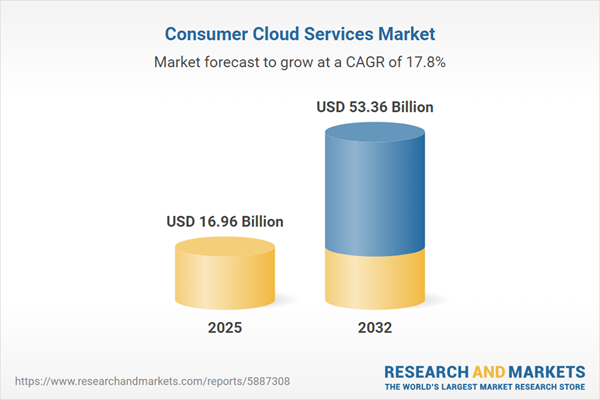Speak directly to the analyst to clarify any post sales queries you may have.
The consumer cloud services market is experiencing rapid transformation as stakeholders adapt to changing user expectations, enhanced security needs, and continuous digital innovation. As enterprises and consumers alike demand higher availability, efficiency, and flexibility, understanding the evolving ecosystem is paramount for decision-makers navigating this landscape.
Market Snapshot: Consumer Cloud Services Growth and Trajectory
The consumer cloud services market grew from USD 14.41 billion in 2024 to USD 16.96 billion in 2025 and is projected to reach USD 53.36 billion by 2032, supported by a compound annual growth rate (CAGR) of 17.77%. This sector demonstrates strong acceleration, underpinned by accelerated digital adoption, substantial investment in scalable infrastructure, and evolving market demands. Market expansion is fueled by end users seeking reliable, integrated solutions that support both professional and personal digital activities.
Scope & Segmentation
This report comprehensively examines market developments, segmentation, and regional trends shaping the landscape for senior business leaders:
- Service Types: Infrastructure as a Service (compute, networking, storage), Platform as a Service (application platforms, database, integration), Software as a Service (collaboration—email & messaging, team chat, video conferencing; content management—document and web management; CRM; ERP).
- Deployment Models: Hybrid (integration, orchestration), Private (hosted, on-premise), Public cloud models.
- Enterprise Size: Large enterprises; Small & Medium enterprises (medium, micro, small).
- End-User Industries: BFSI (banking, capital markets, insurance), Healthcare & Life Sciences (healthcare providers, pharma & biotech), IT & Telecom (internet services, IT services, telecom), Manufacturing (discrete, process), Retail & Consumer Goods (consumer goods, retailers).
- Regional Coverage: Americas (North America—United States, Canada, Mexico; Latin America—Brazil, Argentina, Chile, Colombia, Peru), Europe, Middle East & Africa (Europe—UK, Germany, France, Russia, Italy, Spain, Netherlands, Sweden, Poland, Switzerland; Middle East—UAE, Saudi Arabia, Qatar, Turkey, Israel; Africa—South Africa, Nigeria, Egypt, Kenya), Asia-Pacific (China, India, Japan, Australia, South Korea, Indonesia, Thailand, Malaysia, Singapore, Taiwan).
- Leading Market Players: Alphabet Inc., Apple Inc., Microsoft Corporation, Dropbox, Inc., Box, Inc., Amazon.com, Inc., Backblaze, Inc., OpenText Corporation, Baidu, Inc., Tencent Holdings Limited.
Key Takeaways for Senior Decision-Makers
- The market is strongly influenced by modular architectures and the expanded need for seamless integration across platforms, enhancing agility and customizability for enterprises.
- Transformative technology such as AI-driven automation, edge computing, and next-generation encryption drives innovation and differentiation within service offerings.
- Stakeholder motivations include optimizing costs, improving performance, and enriching the end-user experience, shaping procurement cycles and partnership strategies.
- Providers are increasingly cultivating technology alliances and developer ecosystems, creating value through collaborative solution development and bundled services.
- Regional and regulatory differences call for bespoke go-to-market and compliance strategies, as privacy, data sovereignty, and local partnerships play key roles in market penetration.
- Customer-centric feedback loops are essential, empowering companies to refine product roadmaps and service enhancements in real time.
Tariff Impact on Consumer Cloud Service Ecosystems
The introduction of United States tariff adjustments in 2025 shifts cost structures and supply chain dynamics for cloud service providers. Organizations are responding through regional manufacturing and diversified sourcing, reinforcing operational resilience and optimizing procurement strategies. These changes require active evaluation of customer pricing and contract terms to sustain competitiveness while maintaining reliable end-user experiences.
Methodology & Data Sources
Research insights combine primary interviews with cloud architects, IT executives, and industry leaders, as well as secondary analysis of publications, filings, and technology journals. Rigorous analytical and validation processes—including trend reviews and peer checks—support the credibility and precision of findings.
Why This Report Matters
- Equips executives with actionable intelligence and segment-level insights to guide technology investment and market entry decisions.
- Highlights region-specific risks, compliance obligations, and partnership models necessary for sustainable growth and risk mitigation.
- Enables strategic planning by illuminating evolving stakeholder priorities, industry adoption patterns, and competitive dynamics.
Conclusion
Staying ahead in the consumer cloud services sector requires a nimble, informed approach to strategic innovation and operational decision-making. This report provides reliable, actionable guidance tailored for forward-looking enterprises and leaders.
Additional Product Information:
- Purchase of this report includes 1 year online access with quarterly updates.
- This report can be updated on request. Please contact our Customer Experience team using the Ask a Question widget on our website.
Table of Contents
3. Executive Summary
4. Market Overview
7. Cumulative Impact of Artificial Intelligence 2025
Companies Mentioned
The companies profiled in this Consumer Cloud Services market report include:- Alphabet Inc.
- Apple Inc.
- Microsoft Corporation
- Dropbox, Inc.
- Box, Inc.
- Amazon.com, Inc.
- Backblaze, Inc.
- OpenText Corporation
- Baidu, Inc.
- Tencent Holdings Limited
Table Information
| Report Attribute | Details |
|---|---|
| No. of Pages | 192 |
| Published | November 2025 |
| Forecast Period | 2025 - 2032 |
| Estimated Market Value ( USD | $ 16.96 Billion |
| Forecasted Market Value ( USD | $ 53.36 Billion |
| Compound Annual Growth Rate | 17.7% |
| Regions Covered | Global |
| No. of Companies Mentioned | 11 |









